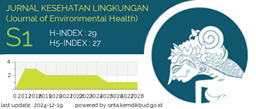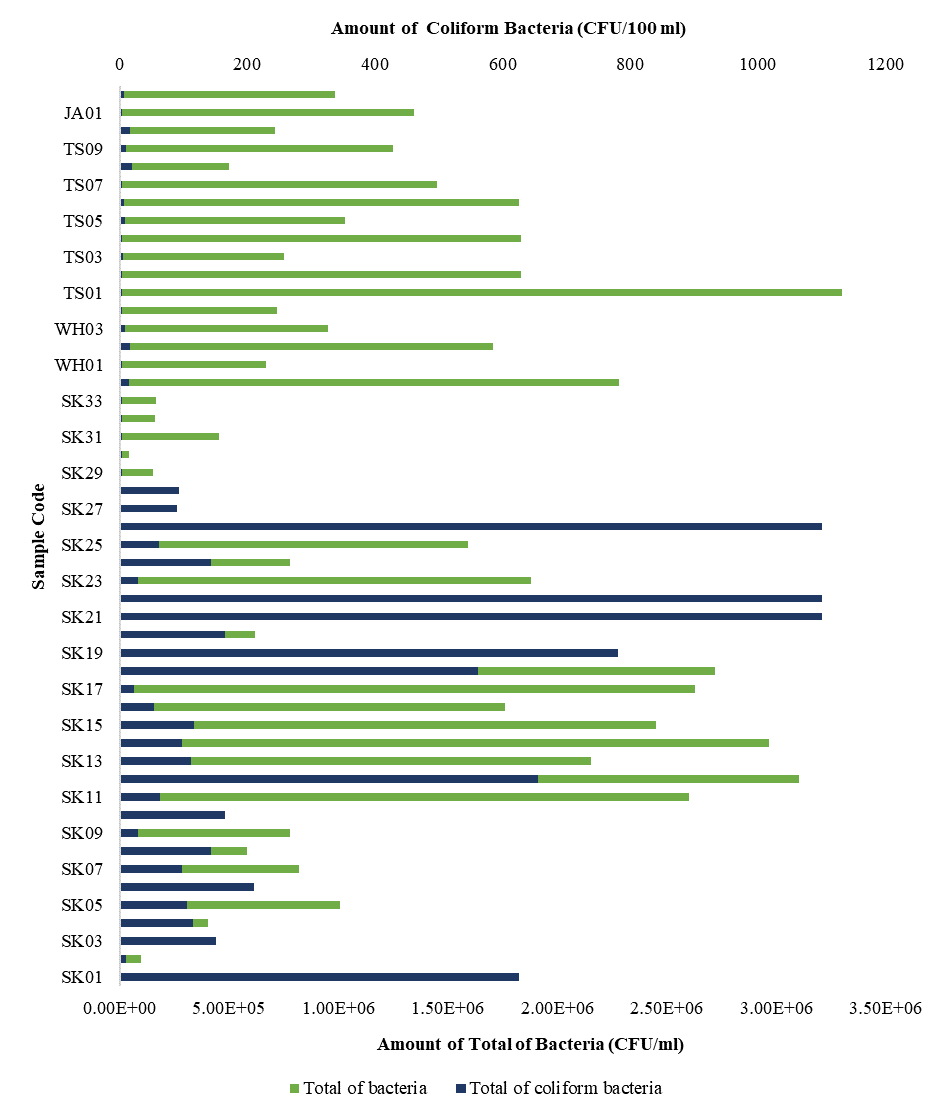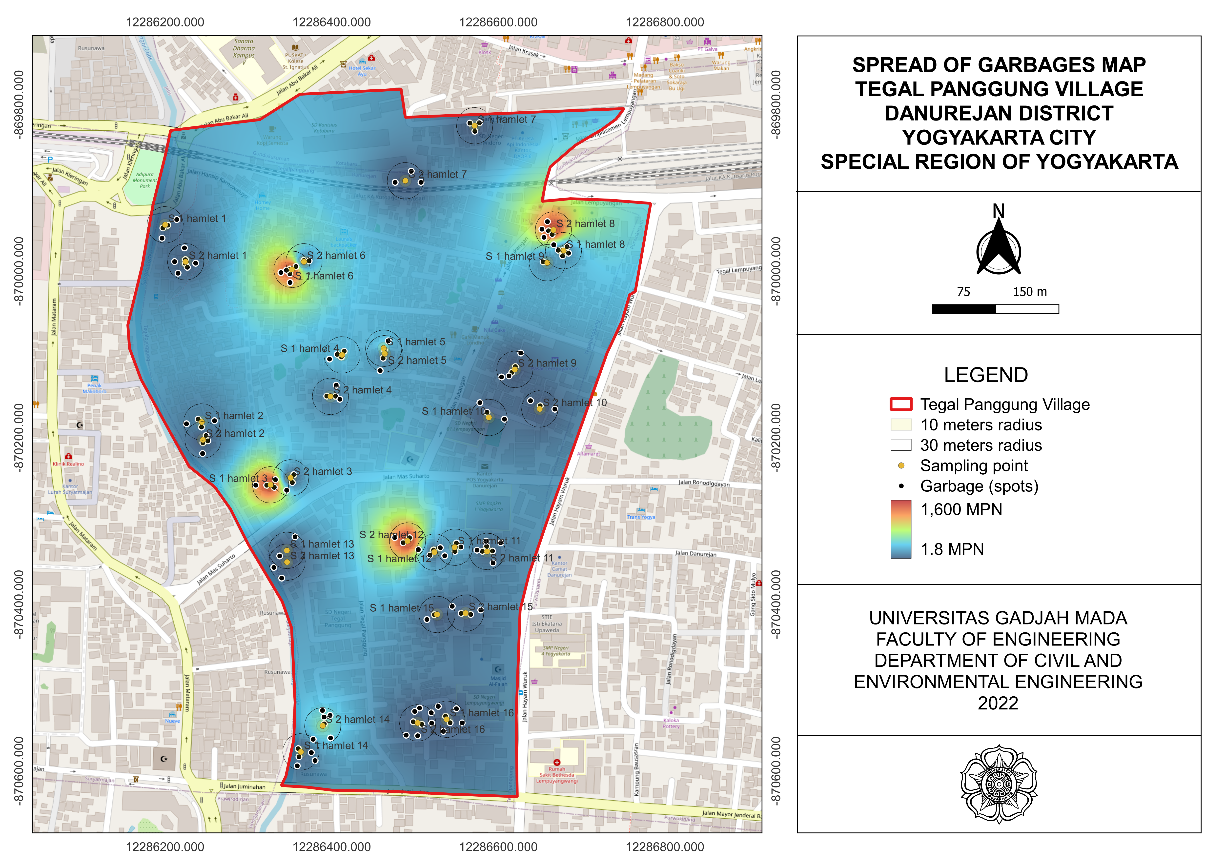Effectiveness of Wastewater Treatment Installation and Liquid Waste Quality in Dr. Soetomo General Hospital, Surabaya
Downloads
Ningrum PT. Gambaran Pengelolaan Limbah Cair di Rumah Sakit X Kabupaten Jember. J IKESMA. 2014;10(2):140-151. https://jurnal.unej.ac.id/index. php/IKESMA/article/view/4833
Maulana M, Kusnanto H, Suwarni A. Pengolahan Limbah Padat Medis dan Pengolahan Limbah Bahan Berbahaya Dan Beracun di RS Swasta Kota Jogja. The 5th URECOL Proceeding. 2017;2 (1):184–190. http://lpp.uad.ac.id/wp-content/ uploads/2017/05/24.-muchsin-184-190.pdf
Yolarita E, Kusuma DW. Pengelolaan Limbah B3 Medis Rumah Sakit di Sumatera Barat Pada Masa Pandemi COVID-19. J Ekol Kesehat. 2020;19(3):148–160. https://ejournal2.litbang. kemkes.go.id/index.php/jek/article/view/3913
Rhomadhoni MN, Ayu F. Evaluasi Hasil Pengolahan Limbah Cair Pada Instalasi Pengolahan Limbah Cair Rumah Sakit Swasta Di Kota Surabaya. J Envirotek. 2019;11(2):14–23. http://envirotek. upnjatim.ac.id/index.php/envirotek/article/view/8/7
Sitepu PY br, Nurmaini, Dharma S. Sistem Pengelolaan Limbah Medis Padat dan Cair serta Faktor-Faktor yang Berkaitan dengan Pelaksanaan Pengelolaan Limbah Medis Padat dan Cair di Rumah Sakit Umum Kabanjahe Kabupaten Karo Tahun 2015. Lingkungan dan Keselamatan Kerja. 2015;4(2):1–9. https://media.neliti.com/media/ publications/14588-ID-sistem-pengelolaan-limbah medis-padat-dan-cair-serta-faktor-faktor-yang berkaita.pdf
Sumalik, Nasrul HW. Management and Processing Processes Regional Waste Of Regional GeneralHospitals (RSUD) Batam City. J Dimens. 2018;7(3):497–517. https://www.journal.unrika. ac.id/index.php/jurnaldms/article/view/1709
Sasiang E, Maddusa SS, Jufri O, Sumampouw. Efektivitas Instalasi Pengolahan Air Limbah Berdasarkan Parameter Biological Oxygen Demand, Chemical Oxygen Demand Dan Derajat Keasaman Di Rumah Sakit Umum Gmim Pancaran Kasih Manado. Jurnal KESMAS. 2019;8(6):608– 615. https://ejournal.unsrat.ac.id/index.php/ kesmas/article/view/26214
World Health Organization. Sanitation Safety Planning: Manual for Safe Use and Dispossal of Wastewater, Greywater and Excreta. France: World Health Organization; 2016. 1-156 p. https://apps. who.int/iris/handle/10665/171753
Afsa S, Hamden K, Lara Martin PA, Mansour H Ben. Occurrence of 40 Pharmaceutically Active Compounds in Hospital and Urban Wastewaters and Their Contribution to Mahdia Coastal Seawater Contamination. Environ Sci Pollut Res Int. 2020;27(2):1941–1955. https://doi.org/10.1007/ s11356-019-06866-5
Nakamura I, Amemura-Maekawa J, Kura F, Kobayashi T, Sato A, Watanabe H, et al. Persistent Legionella Contamination of Water Faucets in A Tertiary Hospital in Japan. Int J Infect Dis. 2020;93(2020):300–304. https://doi.org/10.1016/j. ijid.2020.03.002
Santiago AJ, Burgos-Garay ML, Kartforosh L, Mazher M, Donlan RM. Bacteriophage Treatment of Carbapenemase-Producing Klebsiella Pneumoniae in A Multispecies Biofilm: A Potential Biocontrol Strategy for Healthcare Facilities. AIMS Microbiol. 2020;6(1):43–63. https://doi.org/10.3934/ microbiol.2020003
Dang HTT, Dang HV., Tran TQ. Insights of Healthcare Waste Management Practices in Vietnam. Environ Sci Pollut Res. 2021;28(10):12131–12143. https:// doi.org/10.1007/s11356-020-10832-x
Lochmatter S, Maillard J, Holliger C. Nitrogen removal Over Nitrite by Aeration Control in Aerobic Granular Sludge Sequencing Batch Reactors. Int J Environ Res Public Health. 2014;11(7):6955–6978. https://dx.doi.org/10.3390%2Fijerph110706955
Isik O, Abdelrahman AM, Ozgun H, Ersahin ME, Demir I, Koyuncu I. Comparative Evaluation of Ultrafiltration and Dynamic Membranes in An Aerobic Membrane Bioreactor for Municipal Wastewater Treatment. Environ Sci Pollut Res. 2019;26(32):32723–32733. https://link.springer. com/article/10.1007/s11356-019-04409-6
Beier S, Cramer C, Mauer C, Köster S, Schröder HF, Pinnekamp J. MBR Technology: A Promising Approach for The (Pre-)Treatment of Hospital Wastewater. Water Sci Technol. 2012;65(9):1648– 1653. https://doi.org/10.2166/wst.2012.880
Hu Y, Wang XC, Ngo HH, Sun Q, Yang Y. Anaerobic Dynamic Membrane Bioreactor (AnDMBR) for Wastewater Treatment: A Review. Bioresour Technol. 2018;247(2018):1107–1118. https://doi. org/10.1016/j.biortech.2017.09.101
Pan LT, Han Y. A Novel Anoxic-Aerobic Biofilter Process Using New Composite Packing Material for The Treatment of Rural Domestic Wastewater. Water Sci Technol. 2016;73(10):2486–2492. https:// doi.org/10.2166/wst.2016.099
Setiawan O, Sarto S, Cahyono B. Pengaruh pH Umpan dan Rasio COD / H2O2 terhadap Penurunan COD pada Limbah Cair Rumah Sakit Melalui Metode Fenton. Prosiding Seminar Nasional Teknik Kimia Kejuangan. 2020;1(1):1-6. http://jurnal. upnyk.ac.id/index.php/kejuangan/article/view/3624
Arif S, Zubair H, Nurkin B, Effectiveness of the Implementation of Labuang Baji Regional General Hospital in Makassar City. J. Analisis. 2018;7(2):171–176. http://pasca.unhas.ac.id/jurnal/ files/2bee07b4a032a1e72a3bb50b506abb62.pdf
Ekowati R, Chodir A, Hariyati R, Permata I, Vilutama F, Suhariono. Laporan Pelaksanaan RKL RPL RSUD Dr. Soetomo: Pendahuluan. Surabaya: RSUD Dr. Soetomo; 2020. 1–50 p.
Governor of East Java. Regulation of East Java Governor No. 72 Year 2013 about Wastewater Quality Standards for Industry and/or Other Business Activities. Surabaya: Law Bureau Of The Regional Secretariat Of East Java Province; 2013. 1–15 p. http://arsipjdih.jatimprov.go.id/upload/7698/ PerGub_No._52_Thn_2014_ttg_Perubahan_ PerGub_No._72_Thn_2013_ttg_Baku_Mutu_Air_ Limbah.pdf
Ministry of Environment of Republic Indonesia. Regulation of Ministry of Environment of Republic Indonesia No. 5 Year 2014 About Waste Water Quality Standard. Jakarta: Ministry of Environment of Republic Indonesia; 2014. 1-85 p. https://toolsfortransformation.net/wp-content/ uploads/2017/05/Permen-LH-5-2014-tentang Baku-Mutu-Air-Limbah.pdf
Safoniuk M. Wastewater Engineering: Treatment and Reuse. Chemical Engineering. 2004;111(7):10- 12. https://go.gale.com/ps/i.do?id=GALE%7CA11 9904663&sid=googleScholar&v=2.1&it=r&linkacce ss=abs&issn=00092460&p=AONE&sw=w&userGr oupName=anon%7Eaaca50f4
Alagha O, Allazem A, Bukhari AA, Anil I, Muʹazu ND. Suitability of SBR for Wastewater Treatment and Reuse: Pilot"Scale Reactor Operated in Different Anoxic Conditions. Int J Environ Res Public Health. 2020;17(5):1–13. https://doi.org/10.3390/ ijerph17051617
Fitrianan L, Weliyadi E. Uji Efektivitas Pengolahan Air Limbah Rumah Sakit Pertamedika Menggunakan Sistem Biofilter Aerob-Anaerob. J Harpodon Borneo. 2016;9(2):111–122. http://jurnal.borneo.ac.id/index. php/harpodon/article/view/155
Kerubun AA. Kualitas Limbah Cair Di Rumah Sakit Umum Daerah Tulehu. J Mkmi. 2014;10(3):180– 185. http://journal.unhas.ac.id/index.php/mkmi/ article/view/500
Utami AR. Penurunan Kadar Fosfat Dalam Limbah Rumah Sakit Dengan Menggunakan Reaktor Fitobiofilm. J Teknol Proses dan Inov Ind. 2018;3(1):17-22. http://ejournal.kemenperin.go.id/ JTPII/article/download/4185/3214
Utami AR. Penurunan Kadar Fosfat Dalam Limbah Rumah Sakit Dengan Menggunakan Reaktor Fitobiofilm. J Teknol Proses dan Inov Ind. 2018;3(1):17-22. http://ejournal.kemenperin.go.id/ JTPII/article/download/4185/3214
Huseini MR, Arifah N, Pratiwi WA. Pengaruh Hidrotermal Sekam Padi Terhadap Produksi Biometana Pada Ags – Sbr. J Konversi. 2018;7(2):17–24. https://jurnal.umj.ac.id/index.php/ konversi/article/download/3670/2739
Hartaja DRK. Desain Instalasi Pengolahan Air Limbah Rumah 40 M3/Hari. JRL. 2017;10(2):99– 113. https://ejurnal.bppt.go.id/index.php/JRL/ article/download/2850/2402
Sukadewi NMTE, Astuti NPW, Sumadewi NLU. Efektivitas Sistem Pengolahan Limbah Cair di Rumah Sakit Bali Med Denpasar Tahun 2020. Higiene. 2020;6(2017):114–20. http://journal. uin-alauddin.ac.id/index.php/higiene/article/ view/15781
Manurung AS, Sunarto, Wiryanto. Efektivitas Instalasi Pengolahan Air Limbah dan Kualitas Limbah Cair Rumah Sakit Umum Daerah dr. H. M. Ansari Saleh di Kota Banjarmasin. Ekosains. 2015;7(3):21–9. https://pasca.uns. ac.id/s2ilmulingkungan/wp-content/uploads/ sites/25/2016/09/Efektivitas-Instalasi-Pengolahan Air-Limbah-dan-Kualitas-Limbah-Cair-Rumah Sakit-Umum-Daerah-dr.-H.M.-Ansari-Saleh-di Kota-Banjarmasin-1.pdf
Vo TKQ, Bui XT, Chen SS, Nguyen PD, Cao NDT, Vo TDH, et al. Hospital Wastewater Treatment by Sponge Membrane Bioreactor Coupled with Ozonation Process. Chemosphere. 2019;230(2019):377–383. https://doi.org/10.1016/j. chemosphere.2019.05.009
Qin L, Gao M, Zhang M, Feng L, Liu Q, Zhang G. Application of Encapsulated Algae into MBR for High-Ammonia Nitrogen Wastewater Treatment and Biofouling Control. Water Res. 2020;187(2020):1- 11. https://doi.org/10.1016/j.watres.2020.116430
Situmorang M ulfa. Analisa Efektivitas Pengolahan Limbah Cair Rumah Sakit Bunda Thamrin dengan Parameter COD, BOD, pH, TSS dan MPN Coliform. Skripsi. Medan: Universitas Medan Area; 2019. http://repository.uma.ac.id/bitstream/123456789/11 427/1/158700026%20-%20Muammar%20Ulfa%20 Situmorang%20-%20Fulltext.pdf
Putra TK, Sulistyani, Raharjo M, Suhartono. Efektivitas Penurunan Kadar Amoniak dan Kadar Fosfat di Instalasi Pengolahan Air Limbah RSUD Sunan Kalijaga Demak. J Kesehat Masy. 2018;6(1):680–684. https://ejournal3.undip.ac.id/ index.php/jkm/article/download/20215/19070
Prastiyo CE. Efektivitas Pengolahan Limbah Cair Rumah Sakit Dengan Sistem Dewats Dalam Menurunkan Angka Bakteri Coliform Di RS Panti Wilasa Citarum Semarang. J Kesehatan Masyarakat. 2012;1(2):896–903. https://media. neliti.com/media/publications/18781-ID-efektivitas pengolahan-limbah-cair-rumah-sakit-dengan sistem-dewats-dalam-menuru.pdf
Arifin, Istiqamah, Hamzani S. Efektifitas Instalasi Pengolahan Air Limbah Rumah Sakit "X” Kabupaten Banjar. J Kesehat Lingkung. 2016;13(1):306–314. https://ejournal.kesling-poltekkesbjm.com/index. php/JKL/article/download/27/24
Widayat W, Said NI. Rancang Bangun Paket WWTP Rumah Sakit Dengan Proses Biofilter Anaerob-Aerob, Kapasitas 20-30 m3 per Hari. Neliti. 2005;1(1):52–64. https://media.neliti.com/ media/publications/245139-rancang-bangun paket-WWTP-rumah-sakit-de-5692de75.pdf
Parakh SK, Praveen P, Loh KC, Tong YW. Wastewater Treatment and Microbial Community Dynamics in A Sequencing Batch Reactor Operating under Photosynthetic Aeration. Chemosphere. 2019;215(2019):893–903. https://doi.org/10.1016/j. chemosphere.2018.10.085
Kohlheb N, van Afferden M, Lara E, Arbib Z, Conthe M, Poitzsch C, et al. Assessing The Life Cycle Sustainability of Algae and Bacteria-Based Wastewater Treatment Systems: High-Rate Algae Pond and Sequencing Batch Reactor. J Environ Manage. 2020;264(2020):1-9. https://doi. org/10.1016/j.jenvman.2020.110459
Wei Y, Jin Y, Zhang W. Treatment of High Concentration Wastewater from An Oil and Gas Field via A Paired Sequencing Batch and Ceramic Membrane Reactor. Int J Environ Res Public Health. 2020;17(6):1-11. https://doi.org/10.3390/ijerph17061953
Mulyati M, Narhadi JS. Evaluasi Instalasi Pengolahan Air Limbah Rumah Sakit Rk Charitas Palembang. J Ilmu Lingkungan. 2014;12(2):66–71. https:// ejournal.undip.ac.id/index.php/ilmulingkungan/ article/download/10528/8372
Sudirman. Evaluasi Instalasi Pengolahan Air Limbah Rumah Sakit (Studi Pada Rumah Sakit Jiwa Mutiara Sukma Kota Mataram). Skripsi. Mataram: Universitas Mataram; 2016. http://eprints.unram. ac.id/7258/1/Jurnal%20skripsi.pdf
Andika Bayu , Puji Wahyuningsih RF. Penentuan Nilai Bod Dan Cod Sebagai Parameter Pencemaran Air Dan Baku Mutu Air Limbah Di Pusat Penelitian Kelapa Sawit ( Ppks ) Medan. Quim J Kim Sains dan Terap. 2020;2(1):14–22. https://ejurnalunsam. id/index.php/JQ/article/view/2617
Wibowo M, Rachman RA. Jurnal Presipitasi Kajian Kualitas Perairan Laut Sekitar Muara Sungai Jelitik. J Presipitasi. 2020;17(1):29–37. https://ejournal. undip.ac.id/index.php/presipitasi/article/view/24693
Patricia C, Astono W, Irvindiaty Hendrawan D. Kandungan Nitrat dan Fosfat di Sungai Ciliwung. Seminar Nasional Cendekiawan. 2018;4(1):179- 185. https://www.trijurnal.lemlit.trisakti.ac.id/ semnas/article/view/3373
Atima W. BOD Dan COD Sebagai Parameter Pencemaran Air Dan Baku Mutu Air Limbah. J Biol Sci Educ. 2015;4(1):83–93. https://core.ac.uk/ download/pdf/229361024.pdf
Copyright (c) 2022 JURNAL KESEHATAN LINGKUNGAN

This work is licensed under a Creative Commons Attribution-NonCommercial-ShareAlike 4.0 International License.
1. Copyright of all journal manuscripts is held by the Jurnal Kesehatan Lingkungan.2. Formal legal provisions to access digital articles of electronic journal are subject to the provision of the Creative Commons Attribution-ShareAlike license (CC BY-NC-SA), which means that Jurnal Kesehatan Lingkungan is rightful to keep, transfer media/format, manage in the form of databases, maintain, and publish articles.
3. Published manuscripts both printed and electronic are open access for educational, research, and library purposes. Additionally, the editorial board is not responsible for any violations of copyright law.
JKESLING by UNAIR is licensed under a Creative Commons Attribution-ShareAlike 4.0 International License.







































